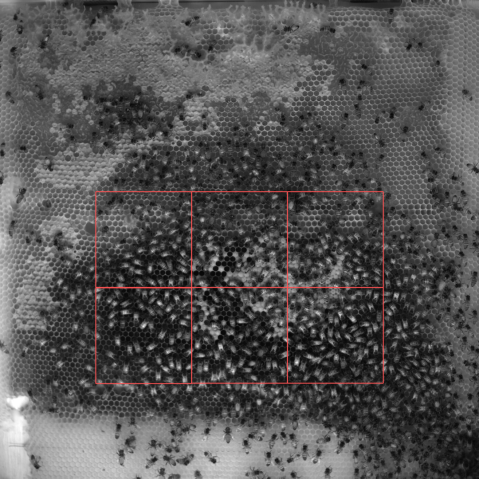Here you can find data resulting from our publications on markerless honeybee detection, pixel-personality and tracking.
Honeybee detection
This dataset was created as a part of the study Towards dense object tracking in a 2D honeybee hive. It comprises frames and annotations of 2 video recordings of an observation bee hive. The recordings were done at 30 fps and 70 fps, in each of them 360 frames were annotated in a consecutive sequence at 2 fps.
The annotation includes positions and orientation angles of all bees in an image within a selected region with high bee density. Annotating was split into tasks on 1024x1024 px windows as shown below:
2 object classes were introduced: (1) fully visible bees, (2) abdomens of bees partially hidden inside cells of a honey comb. The orientation angle of objects of class 2 is always 0. The format of annotation files is:
offset_x offset_y class position_x position_y angle
Files for download:
- frames of 30 fps recording (5 GB)
- annotation of the 30 fps recording
- frames of 70 fps recording (2.5 GB)
- annotation of the 70 fps recording
Due to the size of the images we did not post the full recordings here. If you are interested in other parts of this recording please contact us.
Tutorials
Tutorial with a simplified segmentation-based detection can be found here: https://github.com/oist/DenseObjectDetection. We also provide a checkpoint pretrained on the 30fps dataset.
A parametrizable version of our annotation tool can be found here: https://github.com/oist/DenseObjectAnnotation.
Honeybee tracking I
This dataset is the result of our study Pixel personality for dense object tracking in a 2D honeybee hive and it comprises detection and trajectory information from two beehive recordings. The videos were originally recorded at 30 fps, we downsampled them to 10 fps 5 min segments. Object detections were done as described in the work above. Detection files are numbered according to the video frames and have format: position_x,position_y,object_class,orientation_angle. Trajectory files comprise ~50% of individuals that were correctly tracked for > 80% of time. The file format is frame_nb,position_x,position_y,object_class,orientation_angle.
Files for download:
Recording 1:
Recording 2:
Honeybee tracking II
Here we placed dataset and supplemental information of the study Markerless tracking of an entire honey bee colony. As above, the dataset comprises detection and trajectory information from five beehive recordings at 10 fps 5 min segments.
Supplemental Movies:
- M1 (2.6 MB) Background extracted from hive L1. Each frame represents 12 h of the original recording.
- M2 (70 MB) Background extracted from hive L5. Each frame represents 12 h of the original recording, predicted brood cells are marked in red.
- M3-M7. Example bee trajectories with their corresponding trajectories through the space of visual features. The originally 64-dimensional vectors of visual features representing each bee instance are projected into 3D with the use of t-Distributed Stochastic Neighbor Embedding (t-SNE). Analogous to the plot 3B, 10 most recent representations of the tracked bee are marked in red dots and representations of all other bees from three most recent video frames are marked in yellow dots. Hives: S1 - M3 (10 MB), S2 - M4 (7.7 MB) , S3 - M5 (9.8 MB), S4 - M6 (13 MB), S5 - M7 (7.9 MB).
- M8-M12. Short video snippets provided to visually illustrate the proportion of tracked individuals in each hives. All reference trajectories in hives: S1 - M8 (124 MB), S2 - M9 (126 MB), S3 - M10 (106 MB), S4 - M11 (158 MB), S5 - M12 (113 MB).
- M13-M15. Bees performing waggle dance, whose trajectories are shown in Fig. 5D: M13 (46 MB), M14 (160 MB), M15 (104 MB).
- M16-M18. Bees visiting multiple comb cells, whose trajectories are shown in Fig. 5F: M16 (578 MB), M17 (251 MB), M18 (88 MB).
Dataset files
For each recording (S1-S5) the compressed file contains video, detections and trajectory information:
Tracking pipeline is described in our github repository and sample data was prepared to run the pipeline.






